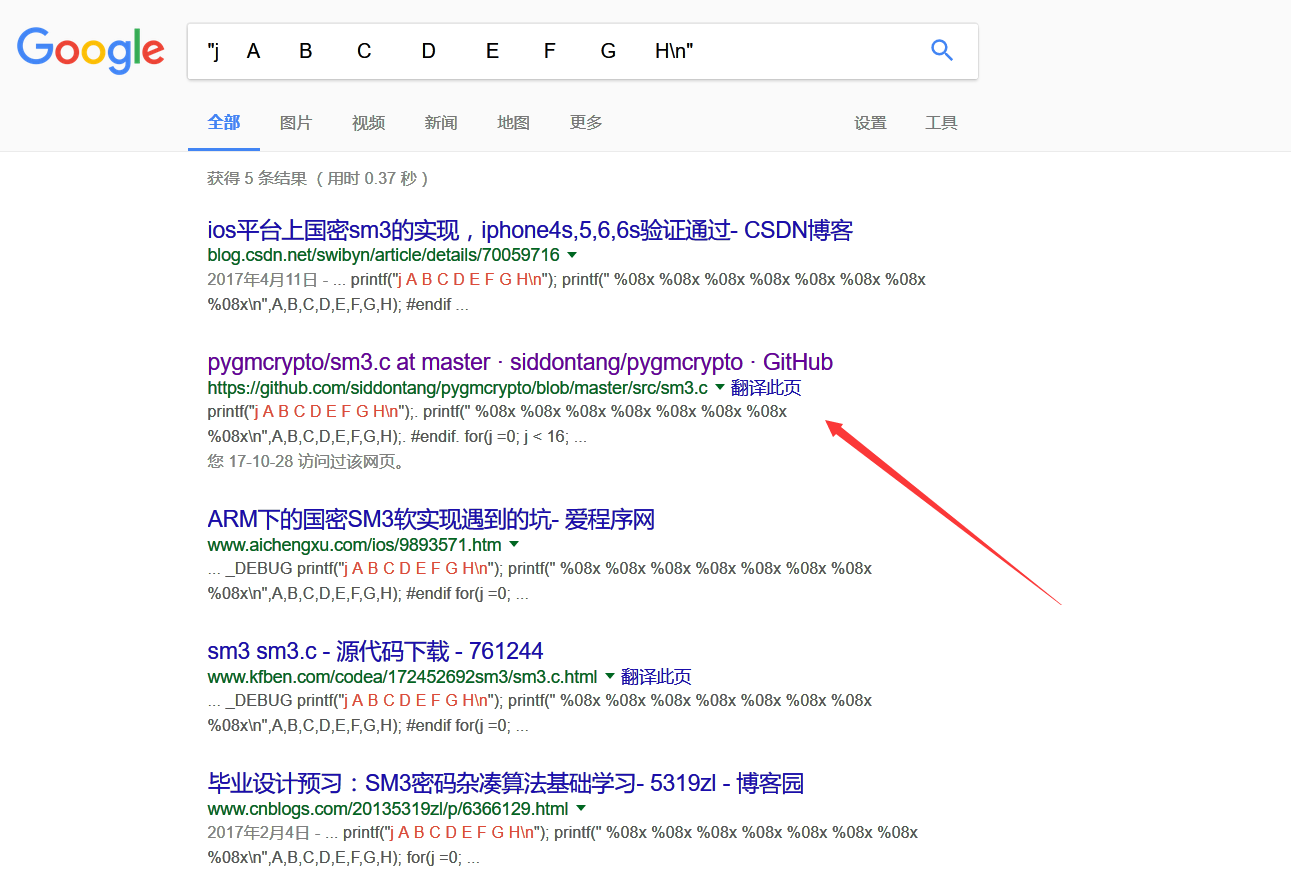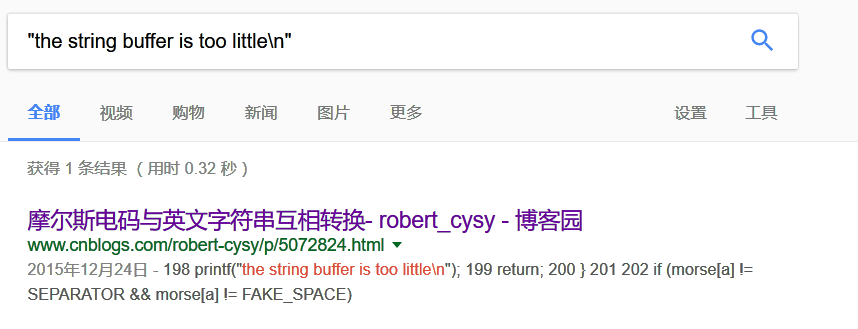-
-
[原创]看雪10月ctf2017 TSRC 第三题——开源CrackMe
-
发表于: 2017-10-29 18:27 3005
-
https://github.com/zhicheng/base64
https://github.com/siddontang/pygmcrypto
len(input) == 64
sm3(base64dec(base64dec(input))[0..3)) == input
sm3(str[0..3)) == base64(base64(str))
base64dec(base64dec(sm3(str[0..3)))) == str
183920f00e15a0433ee3a8fc90dd9ac164c4142ccf63ca189a8f645ec96ff8de a56c3b235fd9802a919afbb7b90d1944532c249e785333b8efd3dacb9d72e63f
第二个试一下,不行,
第一个试一下,过了。。。
不过真的是薛定谔的CM,有时候能过有时候不行。。。
https://github.com/robert1207/morse_encode
1 2 3 4 5 6 7 8 9 10 11 12 13 14 15 16 17 18 19 20 21 22 23 24 25 26 27 28 29 30 31 32 | if ( (unsigned __int16)a3 == 1002 ) { input[0] = 0; memset(&input[1], 0, 1023); input_dec1[0] = 0; memset(&input_dec1[1], 0, 1023); v4 = GetDlgItemTextA(hDlg, 1001, input, 1025); v23 = ret_a2(&v11 == &v11, v4); // wojue de mei sha luan yong input_dec2[0] = 0; memset(&input_dec2[1], 0, 1023); base64_decode((int)input, 1024, (int)input_dec1);//开源的 vbuf19[0] = 0; memset(&vbuf19[1], 0, 1023); base64_decode((int)input_dec1, 1024, (int)input_dec2); some_alg2((int)input_dec2, (int)vbuf19, 1024); v18 = 3; sm3(input_dec2, 3, sm3_hash); // 也是开源的 for ( i = 0; i < 32; ++i ) sprintf((int)&v16[2 * i], "%02x", (unsigned __int8)sm3_hash[i]); _64 = strlen(v16); v6 = &input[strlen(input)]; _1_64 = strlen(v16); if ( !memcmp((int)v16, (int)&v6[-_1_64], _64) ) { sub_42D0B4(v11, v12, v13); if ( (unsigned __int8)final_critical_need_a2_haspace(&unk_49B000, vbuf19) == 1 ) { v8 = MessageBoxA(0, "ok", "CrackMe", 0); ret_a2(&v11 == &v11, v8); } } } |
1 2 3 4 5 6 7 8 9 10 11 12 13 14 15 16 17 18 19 20 21 | sub_42E22A((int)"\n", v17); for ( i = 0; i < 64; ++i ) v37[i] = *(&v47 + i) ^ *(&v43 + i); sub_42E22A((int)"Expanding message W'0-63:\n", v18); for ( j = 0; j < 64; ++j ) { sub_42E22A((int)"%08x ", v37[j]); if ( !((j + 1) % 8) ) sub_42E22A((int)"\n", v19); } sub_42E22A((int)"\n", v19); v36 = a1->dw_arr[0]; v35 = a1->dw_arr[1]; v34 = a1->dw_arr[2]; v33 = a1->dw_arr[3]; v32 = a1->dw_arr[4]; v31 = a1->dw_arr[5]; v30 = a1->dw_arr[6]; v29 = a1->dw_arr[7]; sub_42E22A((int)"j A B C D E F G H\n", v3); sub_42E22A((int)" %08x %08x %08x %08x %08x %08x %08x %08x\n", v36); |

len(input) == 64
sm3(base64dec(base64dec(input))[0..3)) == input
sm3(str[0..3)) == base64(base64(str))
base64dec(base64dec(sm3(str[0..3)))) == str
其实应该还有就是我那个some_alg2 和 final_check == 1的两个算法当时我没逆了,,,看他的代码有点懵逼。。1 2 3 4 5 6 7 8 9 10 11 12 13 14 15 16 17 18 19 20 21 22 23 24 25 26 27 28 29 30 31 32 33 34 35 36 37 38 39 40 41 42 43 44 45 46 47 48 49 50 51 52 53 54 55 56 57 58 59 60 61 62 63 64 65 66 67 68 69 70 71 72 73 74 75 76 77 78 79 80 81 82 83 84 85 86 87 88 89 | #include "base64.h"#include "sm3.h"#include <stdio.h>#include <stdlib.h>#include <string.h>#define UPPER_BOUND_OF_3BYTES 0x01000000#define SM3_LEN 32#define SM3_LEN_ASCII (SM3_LEN * 2)#define SM3_LEN_ASCII_BUFLEN (SM3_LEN_ASCII + 1)#define BASE64X1_LEN (SM3_LEN_ASCII / 4 * 3)#define BASE64X2_LEN (BASE64X1_LEN / 4 * 3)#define BUF_LEN 1024int flag;char sm3_hash[SM3_LEN];char ascii_hash[SM3_LEN_ASCII_BUFLEN];char base64_dec1[BUF_LEN];char base64_dec2[BUF_LEN];void get_ascii_hash(char* hash, char* ret){//pre: ret has size (SM3_LEN*2+1) for (int i = 0; i < SM3_LEN; ++i) sprintf(&ret[2 * i], "%02x", (unsigned __int8)hash[i]); ret[SM3_LEN_ASCII] = 0;}/*sm3(base64dec(base64dec(input))[0..3)) == inputsm3(str[0..3)) == base64(base64(str))base64dec(base64dec(sm3(str[0..3)))) == str*/int isBase64Char(char c){ return ((c | 32) >= 'a' && (c | 32) <= 'z') || c == '=' || c == '+' || c == '/' || (c >= '0' && c <= '9');}int firstThreeSame(char* a1, char* a2){ return a1[0] == a2[0] && a1[1] == a2[1] && a1[2] == a2[2];}int isValidBase64(char* base64, int len){ for (int i = 0; i < len; i++) { if (!isBase64Char(base64[i])) { return 0; } } return 1;}int main(){ for (flag = 0; flag < 0x01000000; flag++) { if ((flag & 0xffff) == 0) { printf("%d\n", flag); } sm3((unsigned char*)&flag, 3, sm3_hash); get_ascii_hash(sm3_hash, ascii_hash); memset(base64_dec1, 0, BUF_LEN); base64_decode(ascii_hash, /*SM3_LEN_ASCII*/BUF_LEN, base64_dec1); memset(base64_dec2, 0, BUF_LEN); if (base64_decode(base64_dec1, /*BASE64X1_LEN*/BUF_LEN, base64_dec2)) { //continue; } /*else { base64_decode(base64_dec1, BASE64X1_LEN, base64_dec2); }//*/ base64_dec2[BASE64X2_LEN] = 0; if (firstThreeSame(base64_dec2, (char*)&flag)) { printf("%s\n", ascii_hash); printf("%s\n", base64_dec2); printf("%s\n", &flag); //system("pause"); } } system("pause");}<br>//这个代码写的比较丑,因为一开始不利用漏洞跑的话一直无解,所以急了。。。最后直接把他的算法直接搬过来了。。。缓冲区用的也是跟他一样的长度。。。 <br> |
183920f00e15a0433ee3a8fc90dd9ac164c4142ccf63ca189a8f645ec96ff8de a56c3b235fd9802a919afbb7b90d1944532c249e785333b8efd3dacb9d72e63f
第二个试一下,不行,
第一个试一下,过了。。。
不过真的是薛定谔的CM,有时候能过有时候不行。。。

https://github.com/robert1207/morse_encode
(看静态字符串一堆-*的时候我就觉得有可能是摩斯。。。1 2 3 4 5 6 7 8 9 10 11 12 13 14 15 16 17 18 19 20 21 | sub_42E22A((int)"\n", v17); for ( i = 0; i < 64; ++i ) v37[i] = *(&v47 + i) ^ *(&v43 + i); sub_42E22A((int)"Expanding message W'0-63:\n", v18); for ( j = 0; j < 64; ++j ) { sub_42E22A((int)"%08x ", v37[j]); if ( !((j + 1) % 8) ) sub_42E22A((int)"\n", v19); } sub_42E22A((int)"\n", v19); v36 = a1->dw_arr[0]; v35 = a1->dw_arr[1]; v34 = a1->dw_arr[2]; v33 = a1->dw_arr[3]; v32 = a1->dw_arr[4]; v31 = a1->dw_arr[5]; v30 = a1->dw_arr[6]; v29 = a1->dw_arr[7]; sub_42E22A((int)"j A B C D E F G H\n", v3); sub_42E22A((int)" %08x %08x %08x %08x %08x %08x %08x %08x\n", v36); |

[培训]内核驱动高级班,冲击BAT一流互联网大厂工作,每周日13:00-18:00直播授课






